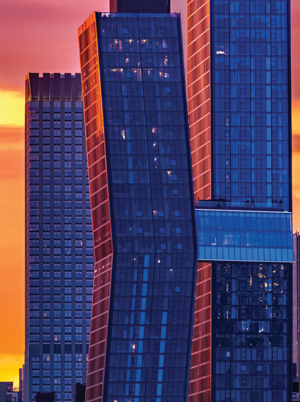Trending
The American Copper Buildings: NYC’s performance art project
The SHoP-designed ‘dancing’ rental towers are elegant now, but how will the morphing facades stand the test of time?

The American Copper Buildings have frequently been compared to a dancing couple. Although that may sound romantic, the buildings’ unique design stems from a far less romantic source: an odd-shaped site.
The 761-unit dual-tower rental project — which was built by JDS Development Group — sits at 626 First Avenue on the site where Sheldon Solow was once planning a $4 billion megaproject. One of the buildings opened for business in April and currently has active listings priced up to about $8,600. The other is set to open later this year.
But while the final project may look as though it was dreamed up purely as a sculptural caprice, the design’s origins rest in a real estate riddle driven by the cold-hard reality that the lot was “not the best,” said architect Gregg Pasquarelli, a partner at SHoP.
To work around the site restrictions, JDS and SHoP ultimately settled on a three-story skybridge to connect two buildings — one of which rises 41 stories, the other 48.
The results are impressive. The project manages to forge a rarely successful cohesiveness between two towers without resorting to excessive melodrama. The use of a skybridge — usually a stiff business handshake between adjacent structures — is not just geographically central to the project, but also central to its kinetically engaged design.
The aim of the skybridge, which is the first built in Manhattan in some 80 years, is to mold two towers into one. “It’s really complicated how that came together,” said Pasquarelli. “It’s actually a mix of the buildings’ DNA to create a parallelogram with six sides.”
The bridge houses 60,000 square feet of amenities, including a 75-foot lap pool, a gym and a lounge — all with sweeping East River views. The buildings appear to be leaning backward, but the angles are not nearly as steep as they appear to the naked eye. They are only about 7 degrees off a standard tower. They just seem severe when you’re used to rigid rectilinearity. The panel arrangement of the towers’ east and west facades was designed to visually bind the project together, Pasquarelli said. “It creates a moiré pattern that radiates from the bridge, so that when the bridge hits the facade, it reads like a radial pattern that comes out from the bridge,” he said.

Gregg Pasquarelli
JDS founder Michael Stern told The Real Deal in June that he wanted to do something other than a “tall glass box” at the site. SHoP, he said, suggested using 4.9 million pounds of copper.
“They are building geeks in the best sense of the word,” Stern said. “We thought they were crazy at first, but our team found a way to get it done.”
All of this brings me to the project’s name. If you haven’t see it in person, you’d be forgiven for thinking it’s the new headquarters of an alloy conglomerate or a former metal manufacturing plant.
American Copper’s name instead celebrates a large-scale experiment with that chameleonic substance — the first copper skyscraper facade in New York. (The Seagram Building is occasionally referred to as a “copper building,” but it’s actually bronze, and its meticulous grooming regimen includes regular oilings to prevent weathering.)
The copper on these towers will lose its shiny sheen with time. They are, in fact, destined for a green future — in the same mold as the wild-haired, green-topped dowagers of the Plaza Hotel or the Woolworth Building, the latter of which houses SHoP’s office.
“When it arrived, it was like a bright shiny penny before it turned to this sort of rich chocolaty brown, and in time it will turn into the green of the Statue of Liberty,” Pasquarelli noted.
“We thought this would be almost like a performance art piece for the city, to watch these buildings over time,” he said. “No one can agree how long it will take, which we think will be spectacular.”
SHoP hasn’t been a stranger to large-scale material experiments. The firm used Cor-Ten, a weathered steel, at the Barclays Center in Brooklyn and terra-cotta at JDS’s 111 West 57th. It was also planning a timber skyscraper, which was ultimately scuttled. Copper is, however, particularly risky given the fact that it is guaranteed to transform radically.
The American Copper Buildings design may not be for everyone. “I see buildings that bend to the right or bend to the left, and they have a sort of clip holding them together, know what I mean? And I wonder what that’s good for,” starchitect Annabelle Selldorf said during a 2016 panel discussion, in a comment that was widely seen as a veiled dig at the project. “It doesn’t satisfy me.”
But for this critic, the towers are rare structures that justify both a skybridge and angles, which are logically linked and would seem bizarre without each other. A design of this level might have been expected for a condo, but it now ups the bar for all new rental buildings in the city.




